Depression and Anxiety: Symptoms, Diagnosis, and Treatment
VerifiedAdded on 2023/04/11
|14
|4068
|246
AI Summary
This article provides an overview of depression and anxiety, including their symptoms, diagnosis, and treatment options. It explores the impact of these mental health disorders and offers insights on managing them effectively.
Contribute Materials
Your contribution can guide someone’s learning journey. Share your
documents today.
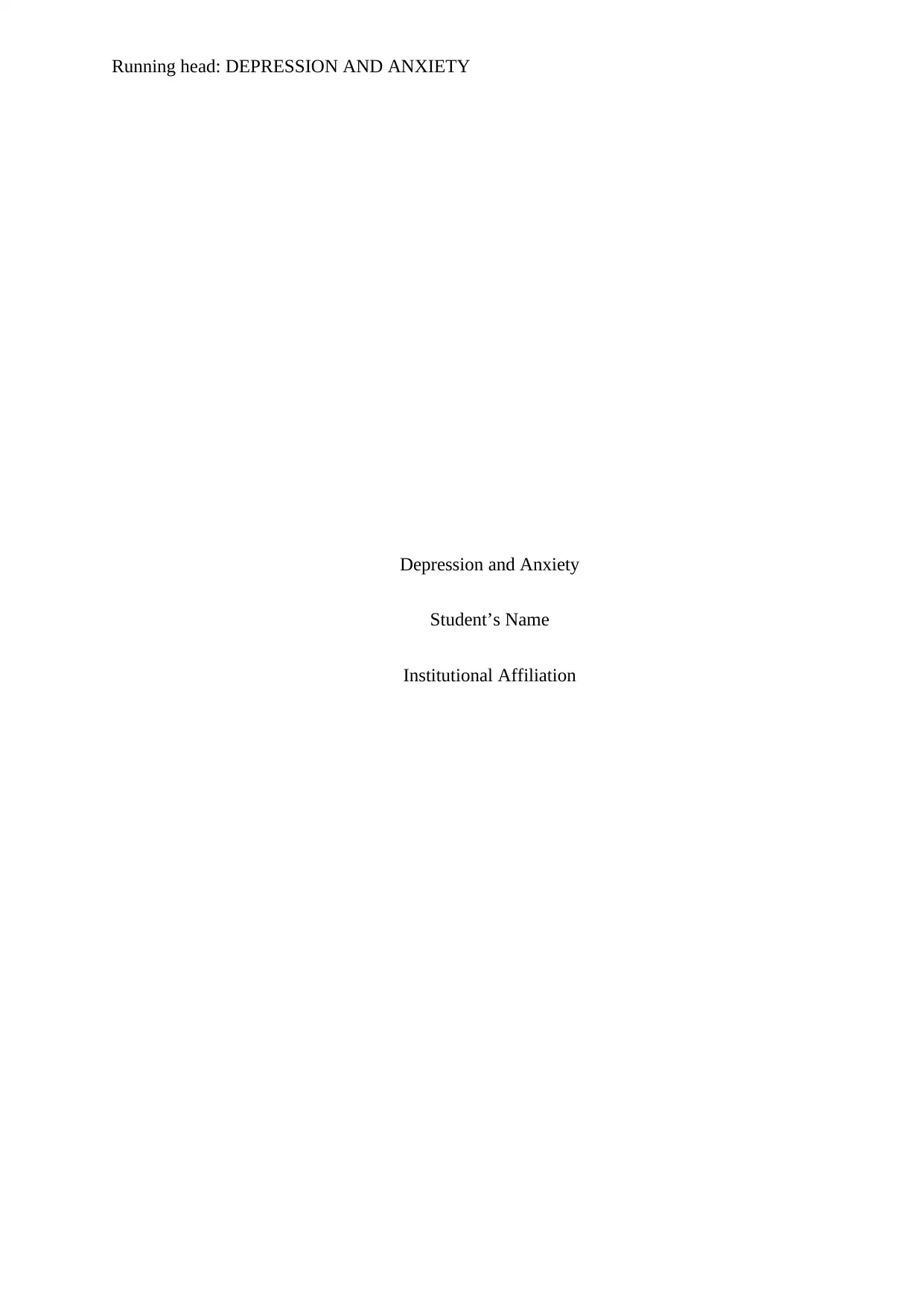
Running head: DEPRESSION AND ANXIETY
Depression and Anxiety
Student’s Name
Institutional Affiliation
Depression and Anxiety
Student’s Name
Institutional Affiliation
Secure Best Marks with AI Grader
Need help grading? Try our AI Grader for instant feedback on your assignments.
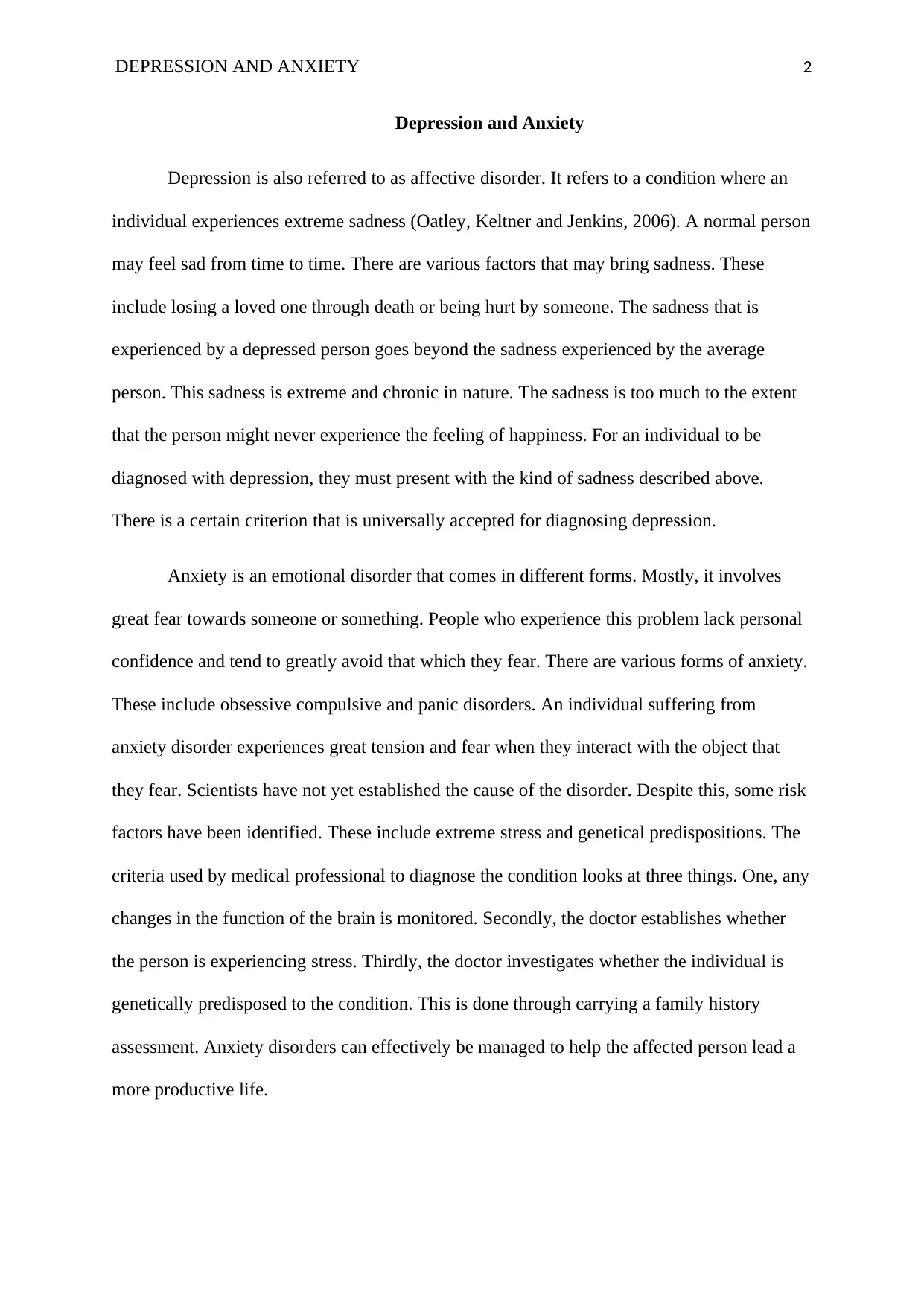
DEPRESSION AND ANXIETY 2
Depression and Anxiety
Depression is also referred to as affective disorder. It refers to a condition where an
individual experiences extreme sadness (Oatley, Keltner and Jenkins, 2006). A normal person
may feel sad from time to time. There are various factors that may bring sadness. These
include losing a loved one through death or being hurt by someone. The sadness that is
experienced by a depressed person goes beyond the sadness experienced by the average
person. This sadness is extreme and chronic in nature. The sadness is too much to the extent
that the person might never experience the feeling of happiness. For an individual to be
diagnosed with depression, they must present with the kind of sadness described above.
There is a certain criterion that is universally accepted for diagnosing depression.
Anxiety is an emotional disorder that comes in different forms. Mostly, it involves
great fear towards someone or something. People who experience this problem lack personal
confidence and tend to greatly avoid that which they fear. There are various forms of anxiety.
These include obsessive compulsive and panic disorders. An individual suffering from
anxiety disorder experiences great tension and fear when they interact with the object that
they fear. Scientists have not yet established the cause of the disorder. Despite this, some risk
factors have been identified. These include extreme stress and genetical predispositions. The
criteria used by medical professional to diagnose the condition looks at three things. One, any
changes in the function of the brain is monitored. Secondly, the doctor establishes whether
the person is experiencing stress. Thirdly, the doctor investigates whether the individual is
genetically predisposed to the condition. This is done through carrying a family history
assessment. Anxiety disorders can effectively be managed to help the affected person lead a
more productive life.
Depression and Anxiety
Depression is also referred to as affective disorder. It refers to a condition where an
individual experiences extreme sadness (Oatley, Keltner and Jenkins, 2006). A normal person
may feel sad from time to time. There are various factors that may bring sadness. These
include losing a loved one through death or being hurt by someone. The sadness that is
experienced by a depressed person goes beyond the sadness experienced by the average
person. This sadness is extreme and chronic in nature. The sadness is too much to the extent
that the person might never experience the feeling of happiness. For an individual to be
diagnosed with depression, they must present with the kind of sadness described above.
There is a certain criterion that is universally accepted for diagnosing depression.
Anxiety is an emotional disorder that comes in different forms. Mostly, it involves
great fear towards someone or something. People who experience this problem lack personal
confidence and tend to greatly avoid that which they fear. There are various forms of anxiety.
These include obsessive compulsive and panic disorders. An individual suffering from
anxiety disorder experiences great tension and fear when they interact with the object that
they fear. Scientists have not yet established the cause of the disorder. Despite this, some risk
factors have been identified. These include extreme stress and genetical predispositions. The
criteria used by medical professional to diagnose the condition looks at three things. One, any
changes in the function of the brain is monitored. Secondly, the doctor establishes whether
the person is experiencing stress. Thirdly, the doctor investigates whether the individual is
genetically predisposed to the condition. This is done through carrying a family history
assessment. Anxiety disorders can effectively be managed to help the affected person lead a
more productive life.

DEPRESSION AND ANXIETY 3
Comparing Different Theories
According to Sternberg (2016), depression refers to mood disorder that prevents
people from living a normal life. Persons suffering from depression cannot socialise normally
within their family or at work. Sternberg (2016) further adds that as many as 27% of the
world’s population is suffering from depression. There are several factors that may cause
depression. These include losing a loved one through death or losing a source of livelihood.
McDougall (2015) on the other hand defines depression as state of sadness that is brought
about by interacting with negative stimulus in the environment. Negative stimuli refer to
anything that invokes the emotion of sadness. If an individual is consistently exposed to such
stimuli, their risk of suffering from depression increases. Freud (2018) observes that
depression is caused by removal of positive reinforcement in a person’s environment. An
example is losing a job. When a person loses a job, they also lose positive reinforcement such
as interacting with people. Freud adds that depressed people exhibit less social interaction
compared to normal people. According Thibaut (2017), a person may suffer from depression
if they lack social skills. Thibaut defines depression as a condition of extreme sadness
brought about by lack of social interaction. People who possess social skills are more likely
to suffer from depression compared to those who possess these skills. A person who lacks
social skills has a very rigid personality structure.
Diagnosis of Depression
For an individual to be diagnosed with depression, they must have exhibited the following
symptoms. One, they have experienced extreme sadness in a period of not less than two
weeks. Extreme sadness means that the person finds no pleasure in any activity that they
engage in. Secondly, the person should have sleeping problems. Depressed people usually
Comparing Different Theories
According to Sternberg (2016), depression refers to mood disorder that prevents
people from living a normal life. Persons suffering from depression cannot socialise normally
within their family or at work. Sternberg (2016) further adds that as many as 27% of the
world’s population is suffering from depression. There are several factors that may cause
depression. These include losing a loved one through death or losing a source of livelihood.
McDougall (2015) on the other hand defines depression as state of sadness that is brought
about by interacting with negative stimulus in the environment. Negative stimuli refer to
anything that invokes the emotion of sadness. If an individual is consistently exposed to such
stimuli, their risk of suffering from depression increases. Freud (2018) observes that
depression is caused by removal of positive reinforcement in a person’s environment. An
example is losing a job. When a person loses a job, they also lose positive reinforcement such
as interacting with people. Freud adds that depressed people exhibit less social interaction
compared to normal people. According Thibaut (2017), a person may suffer from depression
if they lack social skills. Thibaut defines depression as a condition of extreme sadness
brought about by lack of social interaction. People who possess social skills are more likely
to suffer from depression compared to those who possess these skills. A person who lacks
social skills has a very rigid personality structure.
Diagnosis of Depression
For an individual to be diagnosed with depression, they must have exhibited the following
symptoms. One, they have experienced extreme sadness in a period of not less than two
weeks. Extreme sadness means that the person finds no pleasure in any activity that they
engage in. Secondly, the person should have sleeping problems. Depressed people usually

DEPRESSION AND ANXIETY 4
have a hard time sleeping. They may sleep for as little as 4 hours a day. In extreme situations,
the person may be servery sleep deprived. Another symptom that is used in diagnosis of
depression is being slowed down in one’s actions. Individuals with depression may not be
able to make rational decisions. In addition, they may not be eating well. These two factors
contribute to slowing down. Reduced concentration is another symptom that is used in
diagnosis of depression. The concentration span is too low that conversing with the affected
person becomes extremely challenging. Some other symptoms include extreme guilt and
feelings of worthlessness. Due to this, the self-esteem of depressed persons is too low.
Therefore, there is a tendency for these people to have suicidal thoughts. Depression is the
most common emotional disorder. It is worth noting that the condition can be relieved
through establishing a helping relationship with a counsellor. This should be combined with
medications such as antidepressants.
Diagnosis of Anxiety
It may not be easy to diagnose anxiety disorders at times. It is primarily the role of the
doctor to diagnose. However, if the doctor is unable to decide whether a person is suffering
from anxiety disorder or not, they may refer the client to a psychiatrist. The psychiatrist is
specially trained to diagnose and manage psychological conditions and disorders. A
psychologist or another mental health specialist may also be in a position to diagnose and
manage the condition. These specialists carry out the diagnosis process through asking
questions and using appropriate tools. Due to the high level of expertise, these professionals
are very precise and are likely to diagnose the correct psychological condition that an
individual is suffering from. During diagnosis, there are two main things that the
professionals will look for. First, they will want to understand the length of time that a person
has been exhibiting the appropriate diagnostic symptoms. This information is very important
since it helps rule out normal anxiety form anxiety disorder. It is common for a person to fell
have a hard time sleeping. They may sleep for as little as 4 hours a day. In extreme situations,
the person may be servery sleep deprived. Another symptom that is used in diagnosis of
depression is being slowed down in one’s actions. Individuals with depression may not be
able to make rational decisions. In addition, they may not be eating well. These two factors
contribute to slowing down. Reduced concentration is another symptom that is used in
diagnosis of depression. The concentration span is too low that conversing with the affected
person becomes extremely challenging. Some other symptoms include extreme guilt and
feelings of worthlessness. Due to this, the self-esteem of depressed persons is too low.
Therefore, there is a tendency for these people to have suicidal thoughts. Depression is the
most common emotional disorder. It is worth noting that the condition can be relieved
through establishing a helping relationship with a counsellor. This should be combined with
medications such as antidepressants.
Diagnosis of Anxiety
It may not be easy to diagnose anxiety disorders at times. It is primarily the role of the
doctor to diagnose. However, if the doctor is unable to decide whether a person is suffering
from anxiety disorder or not, they may refer the client to a psychiatrist. The psychiatrist is
specially trained to diagnose and manage psychological conditions and disorders. A
psychologist or another mental health specialist may also be in a position to diagnose and
manage the condition. These specialists carry out the diagnosis process through asking
questions and using appropriate tools. Due to the high level of expertise, these professionals
are very precise and are likely to diagnose the correct psychological condition that an
individual is suffering from. During diagnosis, there are two main things that the
professionals will look for. First, they will want to understand the length of time that a person
has been exhibiting the appropriate diagnostic symptoms. This information is very important
since it helps rule out normal anxiety form anxiety disorder. It is common for a person to fell
Secure Best Marks with AI Grader
Need help grading? Try our AI Grader for instant feedback on your assignments.

DEPRESSION AND ANXIETY 5
anxiety from time to time. For it to be referred to as a disorder, then the person must be
exhibiting extreme characteristic. An example would be a person who is too afraid of fire that
they cannot stand a stove even if it is far from them. The second thing that is considered in
diagnosing is whether the symptoms being experienced hinder the individual from leading a
normal life. Most individuals with emotional disorders would be said to have abnormal
psychology. The disorder affects the person so much that they cannot effectively lead a
normal life.
Symptoms and Treatment of Depression
People suffering from depression may exhibit a wide range of symptoms. Although
this is the case, the main symptom is that they exhibit great sadness and loss of pleasure in
daily activities (Miller and Hen, 2015). The other set of symptoms are going to be discussed
here. One of these symptoms is irritability and restlessness. An individual who is suffering
from depression may get angry at the slightest provocation. In addition, they may move from
one place to another in a restless manner. Another symptom is lower sex drive. Experts argue
that this is because of the depressed system. When the system of a person is depressed,
organs such as the heart work in a rate that is slower than normal. Sex drive is lower when the
heart is working at a rate that is slower than normal. This explains why people with
depression have a lower sex drive. Another common symptom among depressed people is
reduced concentration and inability to make rational decisions. Depression affect the brain
and the nervous system in such a way that the person no longer has normal brain function.
This explains the poor judgement and low concentration. Most people suffering from
depression experience insomnia. There is also chance that some individuals may sleep too
much. However, insomnia is the more common symptom. In addition to these symptoms,
people with depression experience exaggerated craving for foods. Some people may become
anorexic while other may eat too much. Depression may also come with physical symptoms
anxiety from time to time. For it to be referred to as a disorder, then the person must be
exhibiting extreme characteristic. An example would be a person who is too afraid of fire that
they cannot stand a stove even if it is far from them. The second thing that is considered in
diagnosing is whether the symptoms being experienced hinder the individual from leading a
normal life. Most individuals with emotional disorders would be said to have abnormal
psychology. The disorder affects the person so much that they cannot effectively lead a
normal life.
Symptoms and Treatment of Depression
People suffering from depression may exhibit a wide range of symptoms. Although
this is the case, the main symptom is that they exhibit great sadness and loss of pleasure in
daily activities (Miller and Hen, 2015). The other set of symptoms are going to be discussed
here. One of these symptoms is irritability and restlessness. An individual who is suffering
from depression may get angry at the slightest provocation. In addition, they may move from
one place to another in a restless manner. Another symptom is lower sex drive. Experts argue
that this is because of the depressed system. When the system of a person is depressed,
organs such as the heart work in a rate that is slower than normal. Sex drive is lower when the
heart is working at a rate that is slower than normal. This explains why people with
depression have a lower sex drive. Another common symptom among depressed people is
reduced concentration and inability to make rational decisions. Depression affect the brain
and the nervous system in such a way that the person no longer has normal brain function.
This explains the poor judgement and low concentration. Most people suffering from
depression experience insomnia. There is also chance that some individuals may sleep too
much. However, insomnia is the more common symptom. In addition to these symptoms,
people with depression experience exaggerated craving for foods. Some people may become
anorexic while other may eat too much. Depression may also come with physical symptoms
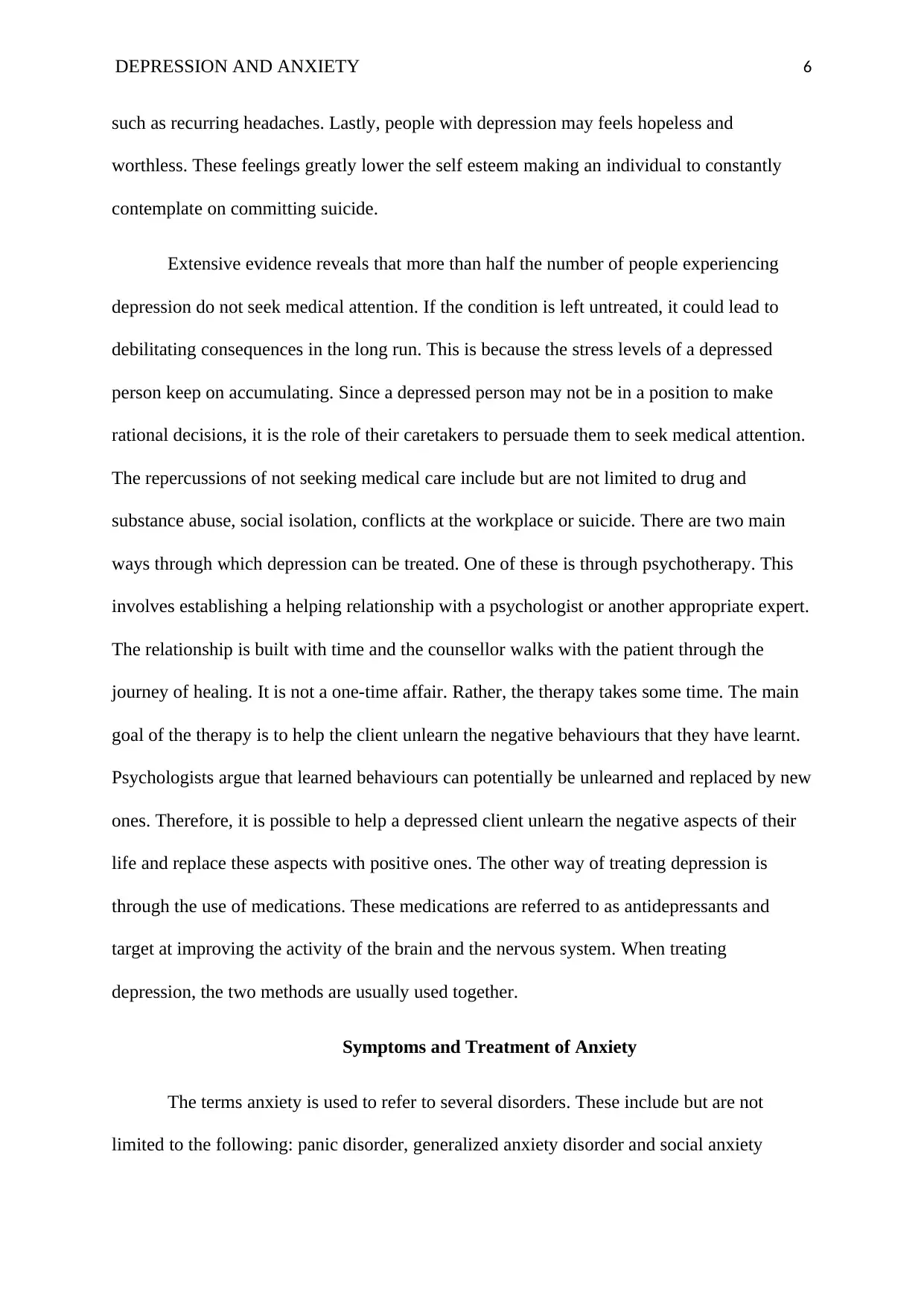
DEPRESSION AND ANXIETY 6
such as recurring headaches. Lastly, people with depression may feels hopeless and
worthless. These feelings greatly lower the self esteem making an individual to constantly
contemplate on committing suicide.
Extensive evidence reveals that more than half the number of people experiencing
depression do not seek medical attention. If the condition is left untreated, it could lead to
debilitating consequences in the long run. This is because the stress levels of a depressed
person keep on accumulating. Since a depressed person may not be in a position to make
rational decisions, it is the role of their caretakers to persuade them to seek medical attention.
The repercussions of not seeking medical care include but are not limited to drug and
substance abuse, social isolation, conflicts at the workplace or suicide. There are two main
ways through which depression can be treated. One of these is through psychotherapy. This
involves establishing a helping relationship with a psychologist or another appropriate expert.
The relationship is built with time and the counsellor walks with the patient through the
journey of healing. It is not a one-time affair. Rather, the therapy takes some time. The main
goal of the therapy is to help the client unlearn the negative behaviours that they have learnt.
Psychologists argue that learned behaviours can potentially be unlearned and replaced by new
ones. Therefore, it is possible to help a depressed client unlearn the negative aspects of their
life and replace these aspects with positive ones. The other way of treating depression is
through the use of medications. These medications are referred to as antidepressants and
target at improving the activity of the brain and the nervous system. When treating
depression, the two methods are usually used together.
Symptoms and Treatment of Anxiety
The terms anxiety is used to refer to several disorders. These include but are not
limited to the following: panic disorder, generalized anxiety disorder and social anxiety
such as recurring headaches. Lastly, people with depression may feels hopeless and
worthless. These feelings greatly lower the self esteem making an individual to constantly
contemplate on committing suicide.
Extensive evidence reveals that more than half the number of people experiencing
depression do not seek medical attention. If the condition is left untreated, it could lead to
debilitating consequences in the long run. This is because the stress levels of a depressed
person keep on accumulating. Since a depressed person may not be in a position to make
rational decisions, it is the role of their caretakers to persuade them to seek medical attention.
The repercussions of not seeking medical care include but are not limited to drug and
substance abuse, social isolation, conflicts at the workplace or suicide. There are two main
ways through which depression can be treated. One of these is through psychotherapy. This
involves establishing a helping relationship with a psychologist or another appropriate expert.
The relationship is built with time and the counsellor walks with the patient through the
journey of healing. It is not a one-time affair. Rather, the therapy takes some time. The main
goal of the therapy is to help the client unlearn the negative behaviours that they have learnt.
Psychologists argue that learned behaviours can potentially be unlearned and replaced by new
ones. Therefore, it is possible to help a depressed client unlearn the negative aspects of their
life and replace these aspects with positive ones. The other way of treating depression is
through the use of medications. These medications are referred to as antidepressants and
target at improving the activity of the brain and the nervous system. When treating
depression, the two methods are usually used together.
Symptoms and Treatment of Anxiety
The terms anxiety is used to refer to several disorders. These include but are not
limited to the following: panic disorder, generalized anxiety disorder and social anxiety
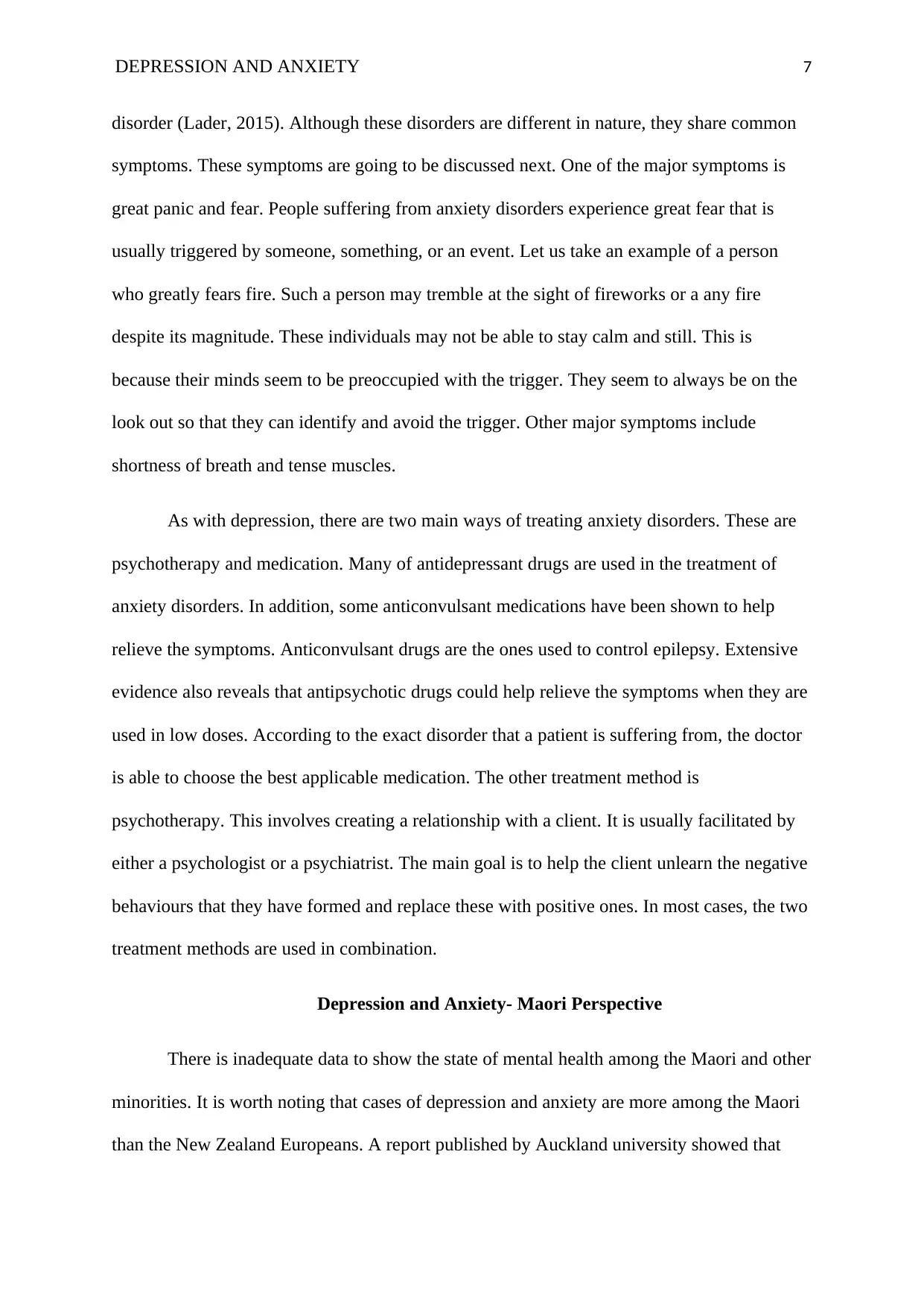
DEPRESSION AND ANXIETY 7
disorder (Lader, 2015). Although these disorders are different in nature, they share common
symptoms. These symptoms are going to be discussed next. One of the major symptoms is
great panic and fear. People suffering from anxiety disorders experience great fear that is
usually triggered by someone, something, or an event. Let us take an example of a person
who greatly fears fire. Such a person may tremble at the sight of fireworks or a any fire
despite its magnitude. These individuals may not be able to stay calm and still. This is
because their minds seem to be preoccupied with the trigger. They seem to always be on the
look out so that they can identify and avoid the trigger. Other major symptoms include
shortness of breath and tense muscles.
As with depression, there are two main ways of treating anxiety disorders. These are
psychotherapy and medication. Many of antidepressant drugs are used in the treatment of
anxiety disorders. In addition, some anticonvulsant medications have been shown to help
relieve the symptoms. Anticonvulsant drugs are the ones used to control epilepsy. Extensive
evidence also reveals that antipsychotic drugs could help relieve the symptoms when they are
used in low doses. According to the exact disorder that a patient is suffering from, the doctor
is able to choose the best applicable medication. The other treatment method is
psychotherapy. This involves creating a relationship with a client. It is usually facilitated by
either a psychologist or a psychiatrist. The main goal is to help the client unlearn the negative
behaviours that they have formed and replace these with positive ones. In most cases, the two
treatment methods are used in combination.
Depression and Anxiety- Maori Perspective
There is inadequate data to show the state of mental health among the Maori and other
minorities. It is worth noting that cases of depression and anxiety are more among the Maori
than the New Zealand Europeans. A report published by Auckland university showed that
disorder (Lader, 2015). Although these disorders are different in nature, they share common
symptoms. These symptoms are going to be discussed next. One of the major symptoms is
great panic and fear. People suffering from anxiety disorders experience great fear that is
usually triggered by someone, something, or an event. Let us take an example of a person
who greatly fears fire. Such a person may tremble at the sight of fireworks or a any fire
despite its magnitude. These individuals may not be able to stay calm and still. This is
because their minds seem to be preoccupied with the trigger. They seem to always be on the
look out so that they can identify and avoid the trigger. Other major symptoms include
shortness of breath and tense muscles.
As with depression, there are two main ways of treating anxiety disorders. These are
psychotherapy and medication. Many of antidepressant drugs are used in the treatment of
anxiety disorders. In addition, some anticonvulsant medications have been shown to help
relieve the symptoms. Anticonvulsant drugs are the ones used to control epilepsy. Extensive
evidence also reveals that antipsychotic drugs could help relieve the symptoms when they are
used in low doses. According to the exact disorder that a patient is suffering from, the doctor
is able to choose the best applicable medication. The other treatment method is
psychotherapy. This involves creating a relationship with a client. It is usually facilitated by
either a psychologist or a psychiatrist. The main goal is to help the client unlearn the negative
behaviours that they have formed and replace these with positive ones. In most cases, the two
treatment methods are used in combination.
Depression and Anxiety- Maori Perspective
There is inadequate data to show the state of mental health among the Maori and other
minorities. It is worth noting that cases of depression and anxiety are more among the Maori
than the New Zealand Europeans. A report published by Auckland university showed that
Paraphrase This Document
Need a fresh take? Get an instant paraphrase of this document with our AI Paraphraser
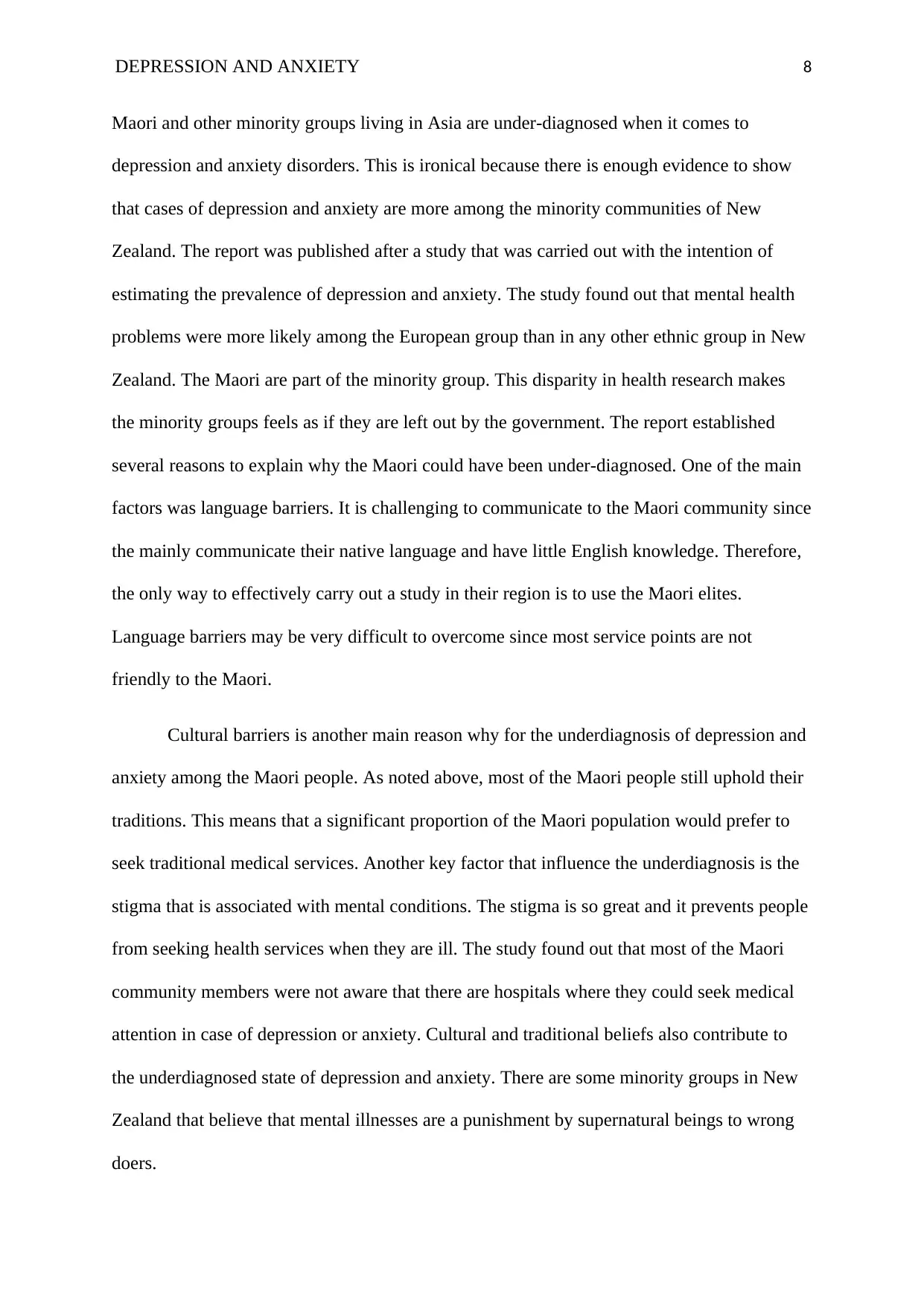
DEPRESSION AND ANXIETY 8
Maori and other minority groups living in Asia are under-diagnosed when it comes to
depression and anxiety disorders. This is ironical because there is enough evidence to show
that cases of depression and anxiety are more among the minority communities of New
Zealand. The report was published after a study that was carried out with the intention of
estimating the prevalence of depression and anxiety. The study found out that mental health
problems were more likely among the European group than in any other ethnic group in New
Zealand. The Maori are part of the minority group. This disparity in health research makes
the minority groups feels as if they are left out by the government. The report established
several reasons to explain why the Maori could have been under-diagnosed. One of the main
factors was language barriers. It is challenging to communicate to the Maori community since
the mainly communicate their native language and have little English knowledge. Therefore,
the only way to effectively carry out a study in their region is to use the Maori elites.
Language barriers may be very difficult to overcome since most service points are not
friendly to the Maori.
Cultural barriers is another main reason why for the underdiagnosis of depression and
anxiety among the Maori people. As noted above, most of the Maori people still uphold their
traditions. This means that a significant proportion of the Maori population would prefer to
seek traditional medical services. Another key factor that influence the underdiagnosis is the
stigma that is associated with mental conditions. The stigma is so great and it prevents people
from seeking health services when they are ill. The study found out that most of the Maori
community members were not aware that there are hospitals where they could seek medical
attention in case of depression or anxiety. Cultural and traditional beliefs also contribute to
the underdiagnosed state of depression and anxiety. There are some minority groups in New
Zealand that believe that mental illnesses are a punishment by supernatural beings to wrong
doers.
Maori and other minority groups living in Asia are under-diagnosed when it comes to
depression and anxiety disorders. This is ironical because there is enough evidence to show
that cases of depression and anxiety are more among the minority communities of New
Zealand. The report was published after a study that was carried out with the intention of
estimating the prevalence of depression and anxiety. The study found out that mental health
problems were more likely among the European group than in any other ethnic group in New
Zealand. The Maori are part of the minority group. This disparity in health research makes
the minority groups feels as if they are left out by the government. The report established
several reasons to explain why the Maori could have been under-diagnosed. One of the main
factors was language barriers. It is challenging to communicate to the Maori community since
the mainly communicate their native language and have little English knowledge. Therefore,
the only way to effectively carry out a study in their region is to use the Maori elites.
Language barriers may be very difficult to overcome since most service points are not
friendly to the Maori.
Cultural barriers is another main reason why for the underdiagnosis of depression and
anxiety among the Maori people. As noted above, most of the Maori people still uphold their
traditions. This means that a significant proportion of the Maori population would prefer to
seek traditional medical services. Another key factor that influence the underdiagnosis is the
stigma that is associated with mental conditions. The stigma is so great and it prevents people
from seeking health services when they are ill. The study found out that most of the Maori
community members were not aware that there are hospitals where they could seek medical
attention in case of depression or anxiety. Cultural and traditional beliefs also contribute to
the underdiagnosed state of depression and anxiety. There are some minority groups in New
Zealand that believe that mental illnesses are a punishment by supernatural beings to wrong
doers.
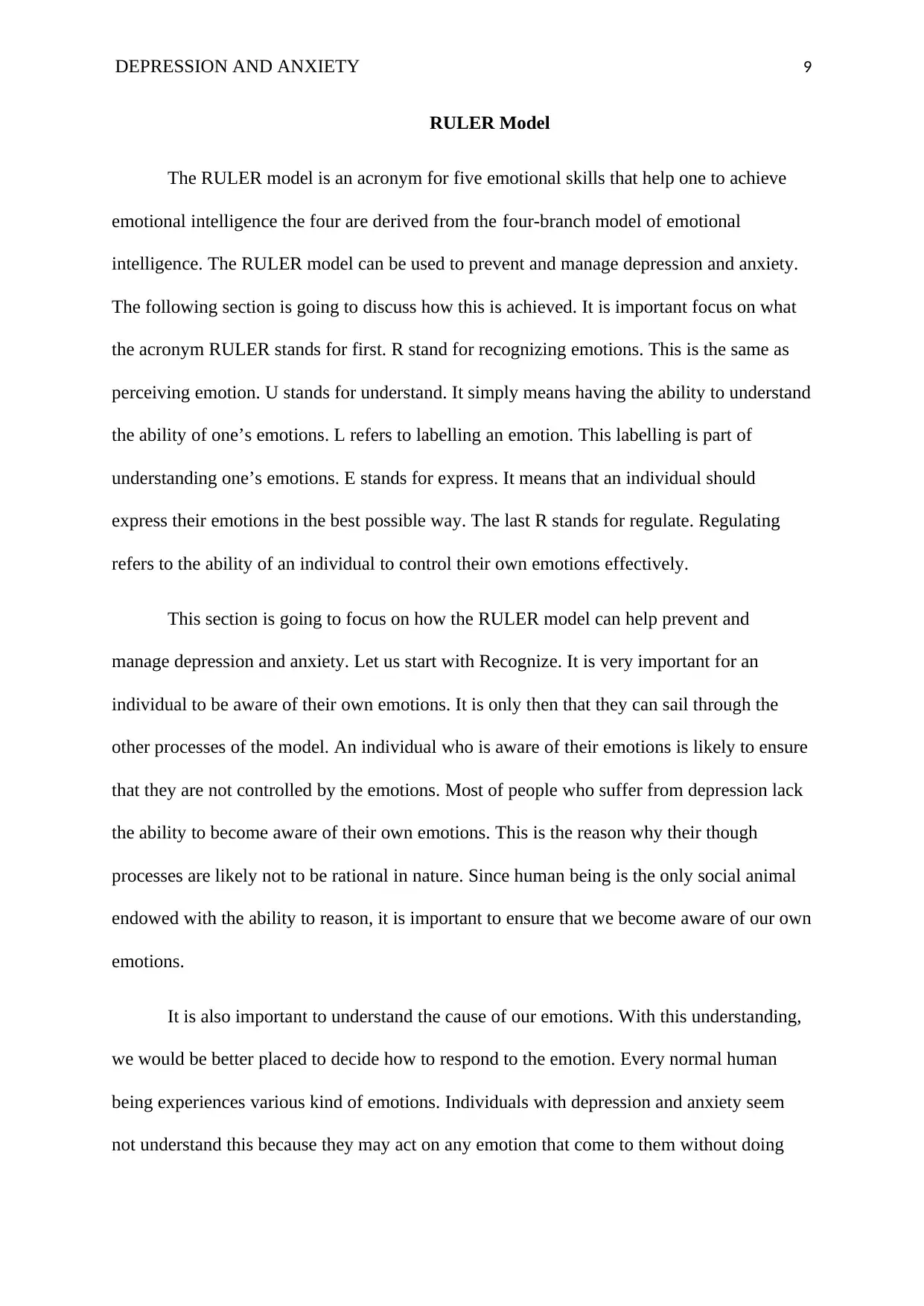
DEPRESSION AND ANXIETY 9
RULER Model
The RULER model is an acronym for five emotional skills that help one to achieve
emotional intelligence the four are derived from the four-branch model of emotional
intelligence. The RULER model can be used to prevent and manage depression and anxiety.
The following section is going to discuss how this is achieved. It is important focus on what
the acronym RULER stands for first. R stand for recognizing emotions. This is the same as
perceiving emotion. U stands for understand. It simply means having the ability to understand
the ability of one’s emotions. L refers to labelling an emotion. This labelling is part of
understanding one’s emotions. E stands for express. It means that an individual should
express their emotions in the best possible way. The last R stands for regulate. Regulating
refers to the ability of an individual to control their own emotions effectively.
This section is going to focus on how the RULER model can help prevent and
manage depression and anxiety. Let us start with Recognize. It is very important for an
individual to be aware of their own emotions. It is only then that they can sail through the
other processes of the model. An individual who is aware of their emotions is likely to ensure
that they are not controlled by the emotions. Most of people who suffer from depression lack
the ability to become aware of their own emotions. This is the reason why their though
processes are likely not to be rational in nature. Since human being is the only social animal
endowed with the ability to reason, it is important to ensure that we become aware of our own
emotions.
It is also important to understand the cause of our emotions. With this understanding,
we would be better placed to decide how to respond to the emotion. Every normal human
being experiences various kind of emotions. Individuals with depression and anxiety seem
not understand this because they may act on any emotion that come to them without doing
RULER Model
The RULER model is an acronym for five emotional skills that help one to achieve
emotional intelligence the four are derived from the four-branch model of emotional
intelligence. The RULER model can be used to prevent and manage depression and anxiety.
The following section is going to discuss how this is achieved. It is important focus on what
the acronym RULER stands for first. R stand for recognizing emotions. This is the same as
perceiving emotion. U stands for understand. It simply means having the ability to understand
the ability of one’s emotions. L refers to labelling an emotion. This labelling is part of
understanding one’s emotions. E stands for express. It means that an individual should
express their emotions in the best possible way. The last R stands for regulate. Regulating
refers to the ability of an individual to control their own emotions effectively.
This section is going to focus on how the RULER model can help prevent and
manage depression and anxiety. Let us start with Recognize. It is very important for an
individual to be aware of their own emotions. It is only then that they can sail through the
other processes of the model. An individual who is aware of their emotions is likely to ensure
that they are not controlled by the emotions. Most of people who suffer from depression lack
the ability to become aware of their own emotions. This is the reason why their though
processes are likely not to be rational in nature. Since human being is the only social animal
endowed with the ability to reason, it is important to ensure that we become aware of our own
emotions.
It is also important to understand the cause of our emotions. With this understanding,
we would be better placed to decide how to respond to the emotion. Every normal human
being experiences various kind of emotions. Individuals with depression and anxiety seem
not understand this because they may act on any emotion that come to them without doing
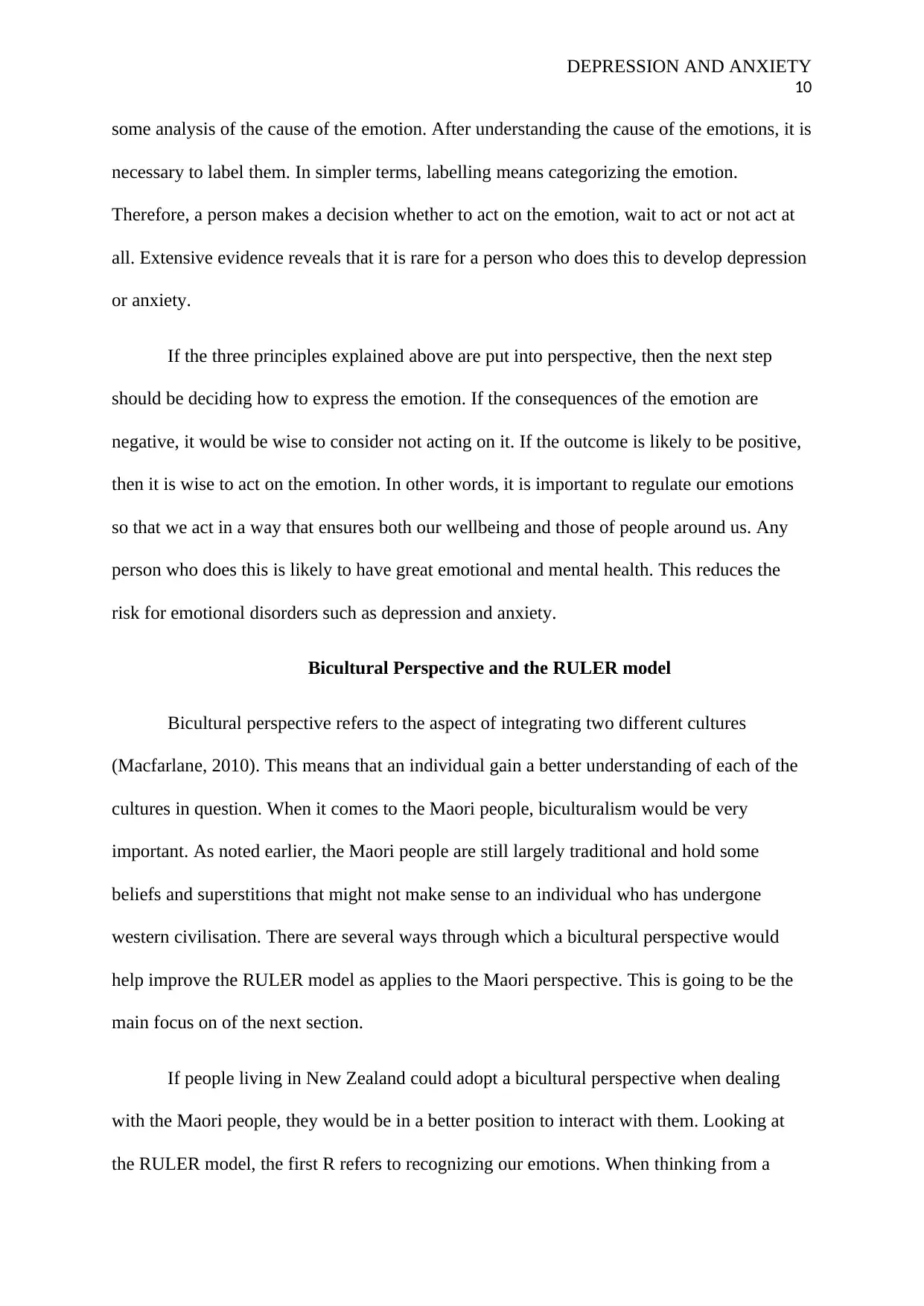
DEPRESSION AND ANXIETY
10
some analysis of the cause of the emotion. After understanding the cause of the emotions, it is
necessary to label them. In simpler terms, labelling means categorizing the emotion.
Therefore, a person makes a decision whether to act on the emotion, wait to act or not act at
all. Extensive evidence reveals that it is rare for a person who does this to develop depression
or anxiety.
If the three principles explained above are put into perspective, then the next step
should be deciding how to express the emotion. If the consequences of the emotion are
negative, it would be wise to consider not acting on it. If the outcome is likely to be positive,
then it is wise to act on the emotion. In other words, it is important to regulate our emotions
so that we act in a way that ensures both our wellbeing and those of people around us. Any
person who does this is likely to have great emotional and mental health. This reduces the
risk for emotional disorders such as depression and anxiety.
Bicultural Perspective and the RULER model
Bicultural perspective refers to the aspect of integrating two different cultures
(Macfarlane, 2010). This means that an individual gain a better understanding of each of the
cultures in question. When it comes to the Maori people, biculturalism would be very
important. As noted earlier, the Maori people are still largely traditional and hold some
beliefs and superstitions that might not make sense to an individual who has undergone
western civilisation. There are several ways through which a bicultural perspective would
help improve the RULER model as applies to the Maori perspective. This is going to be the
main focus on of the next section.
If people living in New Zealand could adopt a bicultural perspective when dealing
with the Maori people, they would be in a better position to interact with them. Looking at
the RULER model, the first R refers to recognizing our emotions. When thinking from a
10
some analysis of the cause of the emotion. After understanding the cause of the emotions, it is
necessary to label them. In simpler terms, labelling means categorizing the emotion.
Therefore, a person makes a decision whether to act on the emotion, wait to act or not act at
all. Extensive evidence reveals that it is rare for a person who does this to develop depression
or anxiety.
If the three principles explained above are put into perspective, then the next step
should be deciding how to express the emotion. If the consequences of the emotion are
negative, it would be wise to consider not acting on it. If the outcome is likely to be positive,
then it is wise to act on the emotion. In other words, it is important to regulate our emotions
so that we act in a way that ensures both our wellbeing and those of people around us. Any
person who does this is likely to have great emotional and mental health. This reduces the
risk for emotional disorders such as depression and anxiety.
Bicultural Perspective and the RULER model
Bicultural perspective refers to the aspect of integrating two different cultures
(Macfarlane, 2010). This means that an individual gain a better understanding of each of the
cultures in question. When it comes to the Maori people, biculturalism would be very
important. As noted earlier, the Maori people are still largely traditional and hold some
beliefs and superstitions that might not make sense to an individual who has undergone
western civilisation. There are several ways through which a bicultural perspective would
help improve the RULER model as applies to the Maori perspective. This is going to be the
main focus on of the next section.
If people living in New Zealand could adopt a bicultural perspective when dealing
with the Maori people, they would be in a better position to interact with them. Looking at
the RULER model, the first R refers to recognizing our emotions. When thinking from a
Secure Best Marks with AI Grader
Need help grading? Try our AI Grader for instant feedback on your assignments.
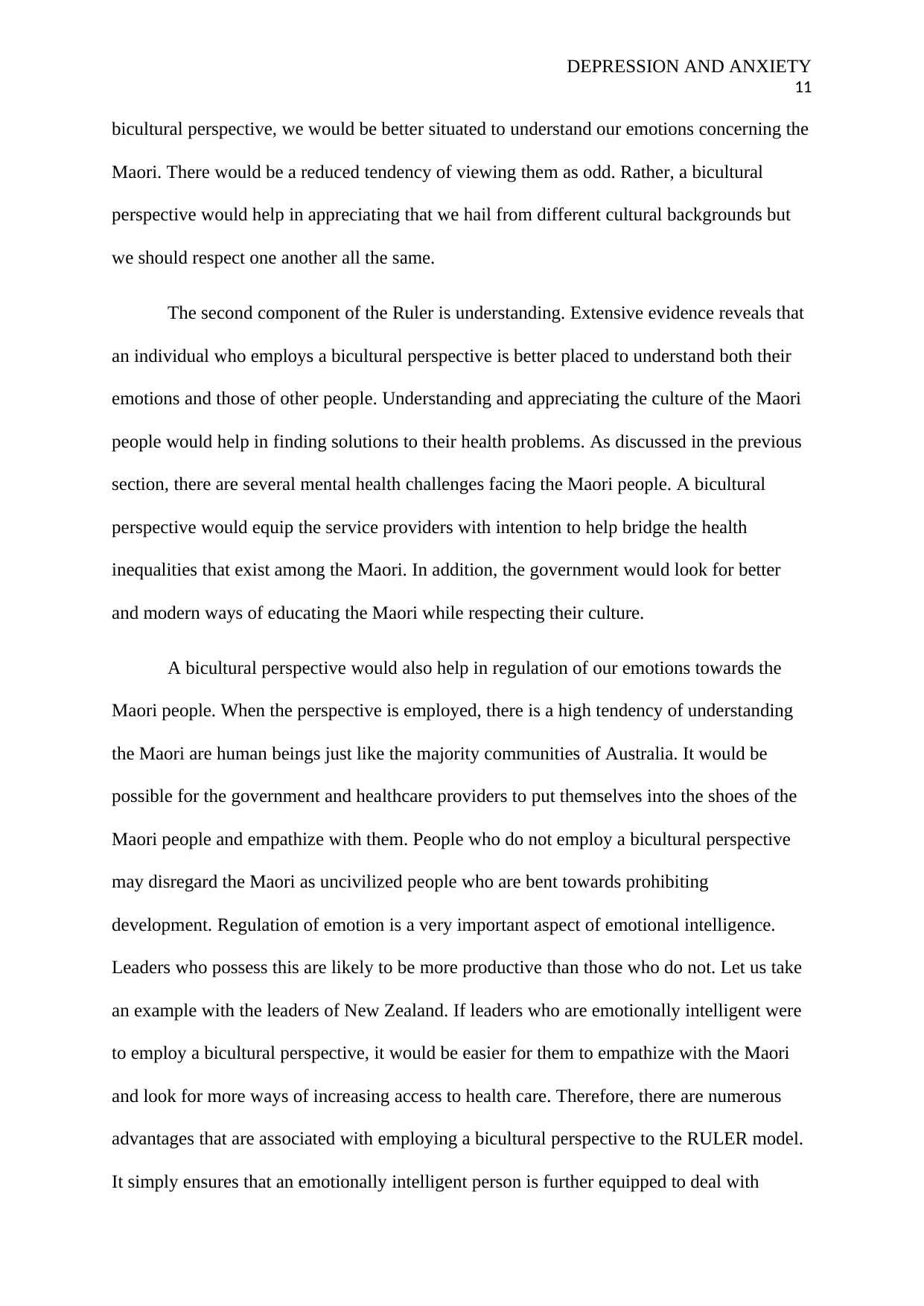
DEPRESSION AND ANXIETY
11
bicultural perspective, we would be better situated to understand our emotions concerning the
Maori. There would be a reduced tendency of viewing them as odd. Rather, a bicultural
perspective would help in appreciating that we hail from different cultural backgrounds but
we should respect one another all the same.
The second component of the Ruler is understanding. Extensive evidence reveals that
an individual who employs a bicultural perspective is better placed to understand both their
emotions and those of other people. Understanding and appreciating the culture of the Maori
people would help in finding solutions to their health problems. As discussed in the previous
section, there are several mental health challenges facing the Maori people. A bicultural
perspective would equip the service providers with intention to help bridge the health
inequalities that exist among the Maori. In addition, the government would look for better
and modern ways of educating the Maori while respecting their culture.
A bicultural perspective would also help in regulation of our emotions towards the
Maori people. When the perspective is employed, there is a high tendency of understanding
the Maori are human beings just like the majority communities of Australia. It would be
possible for the government and healthcare providers to put themselves into the shoes of the
Maori people and empathize with them. People who do not employ a bicultural perspective
may disregard the Maori as uncivilized people who are bent towards prohibiting
development. Regulation of emotion is a very important aspect of emotional intelligence.
Leaders who possess this are likely to be more productive than those who do not. Let us take
an example with the leaders of New Zealand. If leaders who are emotionally intelligent were
to employ a bicultural perspective, it would be easier for them to empathize with the Maori
and look for more ways of increasing access to health care. Therefore, there are numerous
advantages that are associated with employing a bicultural perspective to the RULER model.
It simply ensures that an emotionally intelligent person is further equipped to deal with
11
bicultural perspective, we would be better situated to understand our emotions concerning the
Maori. There would be a reduced tendency of viewing them as odd. Rather, a bicultural
perspective would help in appreciating that we hail from different cultural backgrounds but
we should respect one another all the same.
The second component of the Ruler is understanding. Extensive evidence reveals that
an individual who employs a bicultural perspective is better placed to understand both their
emotions and those of other people. Understanding and appreciating the culture of the Maori
people would help in finding solutions to their health problems. As discussed in the previous
section, there are several mental health challenges facing the Maori people. A bicultural
perspective would equip the service providers with intention to help bridge the health
inequalities that exist among the Maori. In addition, the government would look for better
and modern ways of educating the Maori while respecting their culture.
A bicultural perspective would also help in regulation of our emotions towards the
Maori people. When the perspective is employed, there is a high tendency of understanding
the Maori are human beings just like the majority communities of Australia. It would be
possible for the government and healthcare providers to put themselves into the shoes of the
Maori people and empathize with them. People who do not employ a bicultural perspective
may disregard the Maori as uncivilized people who are bent towards prohibiting
development. Regulation of emotion is a very important aspect of emotional intelligence.
Leaders who possess this are likely to be more productive than those who do not. Let us take
an example with the leaders of New Zealand. If leaders who are emotionally intelligent were
to employ a bicultural perspective, it would be easier for them to empathize with the Maori
and look for more ways of increasing access to health care. Therefore, there are numerous
advantages that are associated with employing a bicultural perspective to the RULER model.
It simply ensures that an emotionally intelligent person is further equipped to deal with

DEPRESSION AND ANXIETY
12
people from different backgrounds. This would be a great way of reducing health disparities
among the Maori.
Research and Application of Emotional Intelligence
When it comes to emotional intelligence, there exists a gap between knowledge and
practice. This means that a person may be aware of what emotional intelligence is but do not
practise it. There are three levels that a person who learning goes through before they can
start practising what they learn. The first step is acquisition of knowledge. After acquiring
this knowledge, it must influence our attitudes positively so that it can translate to practice
(Goleman, 2006). In my professional context, I have always endeavoured to apply emotional
intelligence to ensure that I achieve great results while ensuring optimal emotional and
mental health.
There was a time I worked as a teacher to primary level students. Most of these
students were learning English as their second language When teaching these children, I
applied the principles of emotional intelligence. Due to this, I was able to successfully guide
my students and ensure that they understood the language well. Emotional intelligence also
helped me solve the disputes that could arise among my students in a way that is fair and just.
Although the school was not as developed as those in Western nations when it comes to
technology, I initiated a project to make the school smarter than I found it. With improved
infrastructure, pupils and teachers had a better and improved learning environment. It is also
worth noting that I was working in a culturally diverse environment. There are two main
aspects that helped me interact well with my colleagues and pupils. One of these was the
application of emotional intelligence. The second thing was employing a bicultural
perspective. I never disregarded or disrespected the cultural background of either a fellow
12
people from different backgrounds. This would be a great way of reducing health disparities
among the Maori.
Research and Application of Emotional Intelligence
When it comes to emotional intelligence, there exists a gap between knowledge and
practice. This means that a person may be aware of what emotional intelligence is but do not
practise it. There are three levels that a person who learning goes through before they can
start practising what they learn. The first step is acquisition of knowledge. After acquiring
this knowledge, it must influence our attitudes positively so that it can translate to practice
(Goleman, 2006). In my professional context, I have always endeavoured to apply emotional
intelligence to ensure that I achieve great results while ensuring optimal emotional and
mental health.
There was a time I worked as a teacher to primary level students. Most of these
students were learning English as their second language When teaching these children, I
applied the principles of emotional intelligence. Due to this, I was able to successfully guide
my students and ensure that they understood the language well. Emotional intelligence also
helped me solve the disputes that could arise among my students in a way that is fair and just.
Although the school was not as developed as those in Western nations when it comes to
technology, I initiated a project to make the school smarter than I found it. With improved
infrastructure, pupils and teachers had a better and improved learning environment. It is also
worth noting that I was working in a culturally diverse environment. There are two main
aspects that helped me interact well with my colleagues and pupils. One of these was the
application of emotional intelligence. The second thing was employing a bicultural
perspective. I never disregarded or disrespected the cultural background of either a fellow
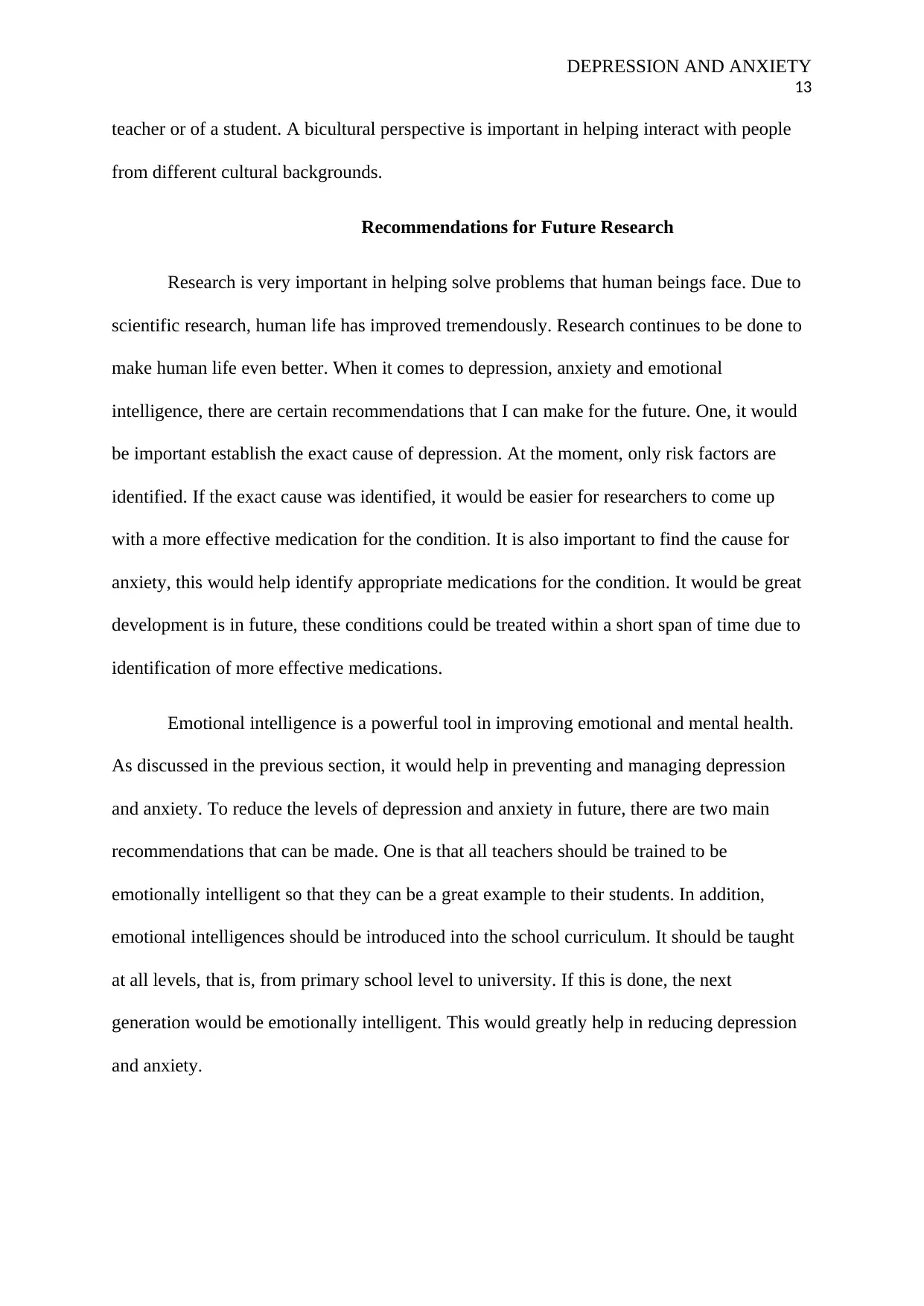
DEPRESSION AND ANXIETY
13
teacher or of a student. A bicultural perspective is important in helping interact with people
from different cultural backgrounds.
Recommendations for Future Research
Research is very important in helping solve problems that human beings face. Due to
scientific research, human life has improved tremendously. Research continues to be done to
make human life even better. When it comes to depression, anxiety and emotional
intelligence, there are certain recommendations that I can make for the future. One, it would
be important establish the exact cause of depression. At the moment, only risk factors are
identified. If the exact cause was identified, it would be easier for researchers to come up
with a more effective medication for the condition. It is also important to find the cause for
anxiety, this would help identify appropriate medications for the condition. It would be great
development is in future, these conditions could be treated within a short span of time due to
identification of more effective medications.
Emotional intelligence is a powerful tool in improving emotional and mental health.
As discussed in the previous section, it would help in preventing and managing depression
and anxiety. To reduce the levels of depression and anxiety in future, there are two main
recommendations that can be made. One is that all teachers should be trained to be
emotionally intelligent so that they can be a great example to their students. In addition,
emotional intelligences should be introduced into the school curriculum. It should be taught
at all levels, that is, from primary school level to university. If this is done, the next
generation would be emotionally intelligent. This would greatly help in reducing depression
and anxiety.
13
teacher or of a student. A bicultural perspective is important in helping interact with people
from different cultural backgrounds.
Recommendations for Future Research
Research is very important in helping solve problems that human beings face. Due to
scientific research, human life has improved tremendously. Research continues to be done to
make human life even better. When it comes to depression, anxiety and emotional
intelligence, there are certain recommendations that I can make for the future. One, it would
be important establish the exact cause of depression. At the moment, only risk factors are
identified. If the exact cause was identified, it would be easier for researchers to come up
with a more effective medication for the condition. It is also important to find the cause for
anxiety, this would help identify appropriate medications for the condition. It would be great
development is in future, these conditions could be treated within a short span of time due to
identification of more effective medications.
Emotional intelligence is a powerful tool in improving emotional and mental health.
As discussed in the previous section, it would help in preventing and managing depression
and anxiety. To reduce the levels of depression and anxiety in future, there are two main
recommendations that can be made. One is that all teachers should be trained to be
emotionally intelligent so that they can be a great example to their students. In addition,
emotional intelligences should be introduced into the school curriculum. It should be taught
at all levels, that is, from primary school level to university. If this is done, the next
generation would be emotionally intelligent. This would greatly help in reducing depression
and anxiety.
Paraphrase This Document
Need a fresh take? Get an instant paraphrase of this document with our AI Paraphraser
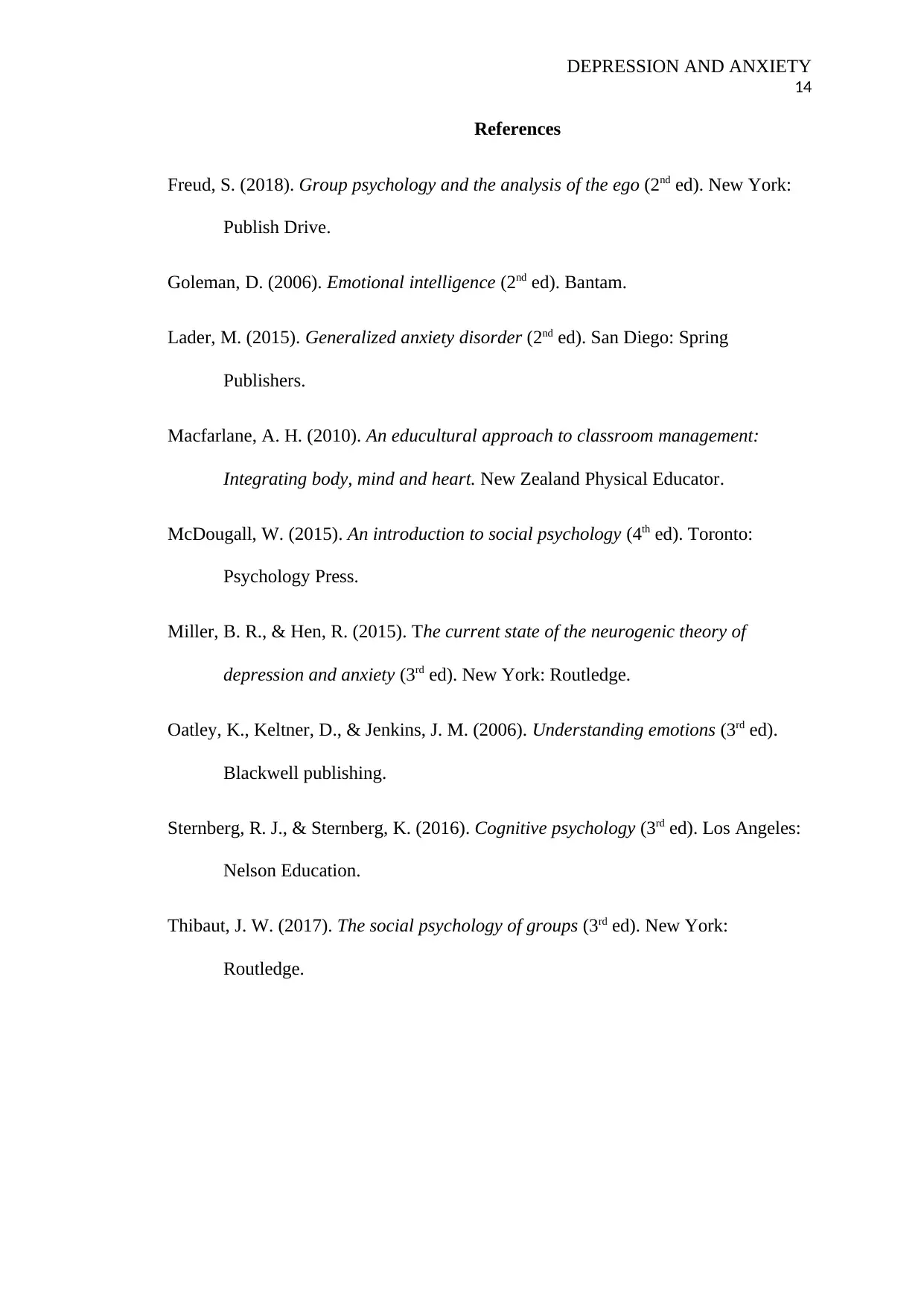
DEPRESSION AND ANXIETY
14
References
Freud, S. (2018). Group psychology and the analysis of the ego (2nd ed). New York:
Publish Drive.
Goleman, D. (2006). Emotional intelligence (2nd ed). Bantam.
Lader, M. (2015). Generalized anxiety disorder (2nd ed). San Diego: Spring
Publishers.
Macfarlane, A. H. (2010). An educultural approach to classroom management:
Integrating body, mind and heart. New Zealand Physical Educator.
McDougall, W. (2015). An introduction to social psychology (4th ed). Toronto:
Psychology Press.
Miller, B. R., & Hen, R. (2015). The current state of the neurogenic theory of
depression and anxiety (3rd ed). New York: Routledge.
Oatley, K., Keltner, D., & Jenkins, J. M. (2006). Understanding emotions (3rd ed).
Blackwell publishing.
Sternberg, R. J., & Sternberg, K. (2016). Cognitive psychology (3rd ed). Los Angeles:
Nelson Education.
Thibaut, J. W. (2017). The social psychology of groups (3rd ed). New York:
Routledge.
14
References
Freud, S. (2018). Group psychology and the analysis of the ego (2nd ed). New York:
Publish Drive.
Goleman, D. (2006). Emotional intelligence (2nd ed). Bantam.
Lader, M. (2015). Generalized anxiety disorder (2nd ed). San Diego: Spring
Publishers.
Macfarlane, A. H. (2010). An educultural approach to classroom management:
Integrating body, mind and heart. New Zealand Physical Educator.
McDougall, W. (2015). An introduction to social psychology (4th ed). Toronto:
Psychology Press.
Miller, B. R., & Hen, R. (2015). The current state of the neurogenic theory of
depression and anxiety (3rd ed). New York: Routledge.
Oatley, K., Keltner, D., & Jenkins, J. M. (2006). Understanding emotions (3rd ed).
Blackwell publishing.
Sternberg, R. J., & Sternberg, K. (2016). Cognitive psychology (3rd ed). Los Angeles:
Nelson Education.
Thibaut, J. W. (2017). The social psychology of groups (3rd ed). New York:
Routledge.
1 out of 14
Related Documents
Your All-in-One AI-Powered Toolkit for Academic Success.
+13062052269
info@desklib.com
Available 24*7 on WhatsApp / Email
![[object Object]](/_next/static/media/star-bottom.7253800d.svg)
Unlock your academic potential
© 2024 | Zucol Services PVT LTD | All rights reserved.





